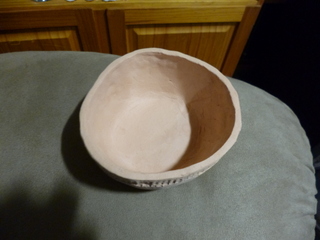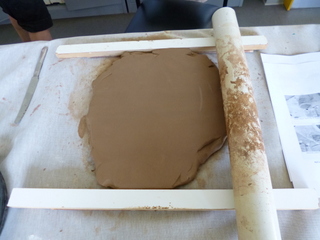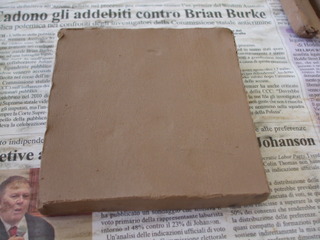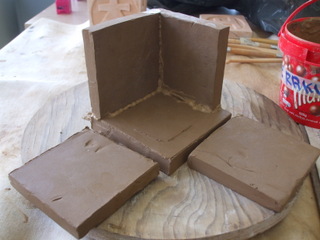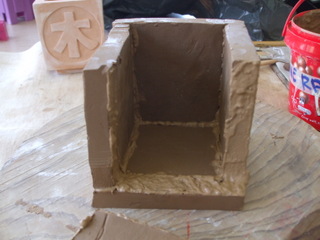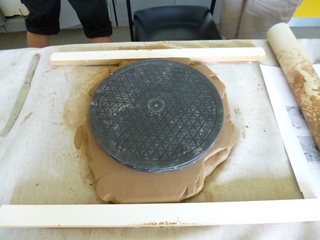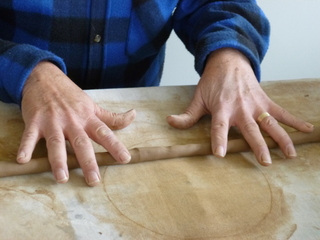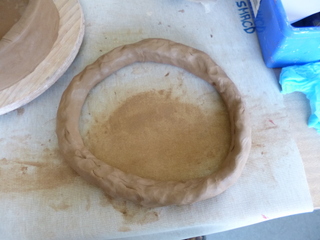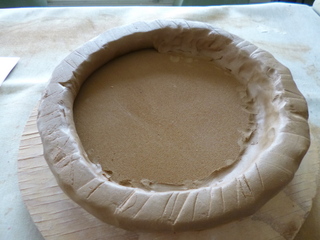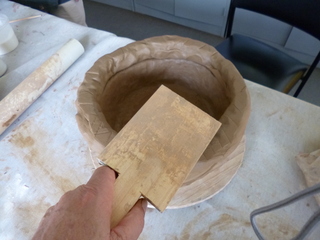Simple Pottery Without a Wheel - Techniques
When I talk about basic pottery techniques I mean techniques that require a minimum of special equipment and that you do not need a potter’s wheel for, they can be done just by hand. There are three main ones, pinching, slabbing and coiling.
Pinching
Making a pot using this technique is very simple, roll up a ball of clay about the size of your fist, then stick your thumb into it to make a well or hole. Then slowly pinch (now, you’re getting it!) the sides and bottom out thinner and thinner until you have a bowl with walls about 6mm thick, then flatten the bottom so it will sit in a stable manner. You can decorate it if you desire, I drew a line around the top and then used a stamp to make an imprint before the clay got too hard. Let the pot dry and then fire it – easy!
While this technique is the easiest and requires only your hands to form, it is not very versatile and what you see is really pretty much the extent of what you can do. If you want to make a whole stack of fairly simple and not too big pots, this is the simplest and quickest way to do it.

Slabbing
Slabbing requires a bit more skill and gear, particularly a rolling pin and some roller guides. Once your clay has been kneaded and is nice and pliable, pat out a slab a bit thicker than the estimated sides of your pot and place it on your work surface. Place the roller guides on each side and then use the rolling pin to flatten the clay down to the thickness of the guides. Obtain or make a template the size of the sides, base and lid (if you want a lid that is...) and cut a side out of your rolled slab, I just use a repurposed butter knife to make the cuts but there are specific potter’s knives available. To make all the other sides, base and lid, just repeat the above until all are cut out.
The sides of your slab pot may be a bit soft for assembly and could collapse if you try and fit them together and if this is the case, place them in a plastic bag with a sheet of newspaper so they will dry out slowly and check them in a few days to a week. Once they have hardened up a bit you can assemble the base and sides of the box using the “score and slip” technique but before you can do that, you need to make some slip. In this case slip is not what ladies wear under their skirts or what you do after stepping on a banana peel, is a watery clay slurry. It can be made by soaking some of your potting clay in water, to speed the process up reduce the clay to fine shavings. Sloshing the clay chips around in the water will help them slurry up as well.
The “score” part consists of making a crosshatch of shallow score lines in the clay where the side attaches to the base or to another side using a sharp tool, but a bamboo satay skewer will work. In the case of a box, you can start out by crosshatching the base, using your finger to spread on some of the (hopefully thick and clayey) slip, then put the side on. When the side is in place a belt with a wooden bat (called interestingly enough among our pottery group a “bang bang”) will help secure it. It is then just a case of repeating the process until all sides are attached to the base and to each other.
To reinforce the joins, roll out a thin “worm” of clay, lay it along where one of the sides joins the base and then force it into the joint with a finger, smoothing it off and removing excess clay in the process. Repeat this on all of the internal joints and your box will be reasonably strong.
The lid should be the same size as the base and formed in the same way. To make sure the lid doesn’t slide off the box, roll out some more slab clay and cut some one centimetre wide lengths then draw out where the walls will come to on the lid. Do the score and slip thing inside the line to use the cut one cm lengths to form a square on the side of the lid which goes against the box. This forms a rim to keep the lid steady. Make the worms again and squished them into both sides of the rim corners to reinforce them and make sure they stay on until the pot is fired.
You can follow the same process on the bottom of the box to put a lip which gets the whole box up off the ground and gives it a finished look. I used my home made carving tool to put a simple design on each of the four sides to dress it up a bit but I’m not much of an artist.
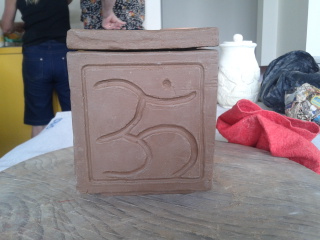
Coiling
From my adventures with pottery, the process of coiling seems to be the most versatile of the three techniques, enabling you to make all sorts of useful things.
Start out with a slab base in the same way as in “slabbing” above, although for coil pots it is usually round and probably about 10mm thick at least, but a big pot needs a bigger, thicker base. Then form clay rolls with your fingers spread, rolling them along your work surface just like when you used play dough when you were a kid. Again, the size of the rolls will be directly proportional to the size of the pot so if you start out to say, make a pot 90mm deep by 140mm wide at the top, the base and rolls being 10mm thick would work.
Place the first coil around the outside of your base and give it a few hits with a bat to start the clay adhering onto the base below it and then smooth both the inside and outside of the coil into the base so it forms a smoothly contoured surface. Repeat the process, making sure each time that the top coil is blended in with the one below it and give it a couple of hits with the bat as well. If you don’t finish the pot in one sitting, wrap it in plastic bags (preferably several layers) and leave it in a cool place until you can get back to it. If it has dried out a bit when you do get back to it you may have to use the “score and slip” technique when the first soft coil is applied to the harder top coil of the existing pot.
As you build the coil walls of the pot, pound them with the bat on the outside as you support the clay with your fingers on the inside, this will make the clay tougher, smoother and denser resulting in a stronger pot.
Finishing
Any of these pots may be given a smoother surface by running over the outside and inside with a rubber kidney (a kidney shaped potting tool, strangely enough!). This will give a better profile and also help to make the surface denser and stronger. Once you are happy with the surface you can carve in any design you like. If you want to glaze your pot, it will need to be fired in a kiln first to bisque firing temperature (1000°C +) first, glazed and then re-fired to glazing temperature.
